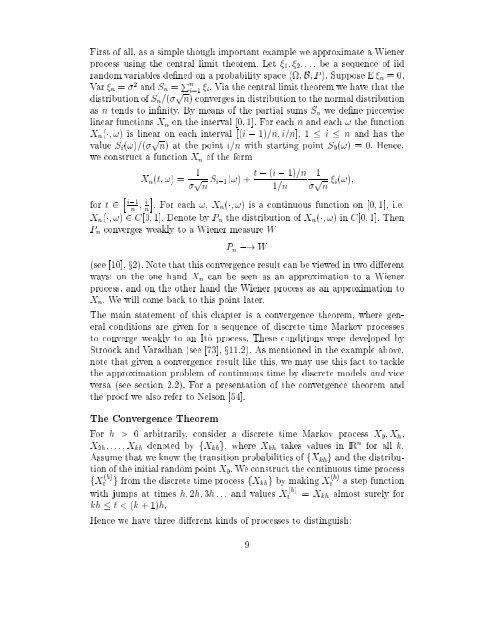Estimation in Financial Models - RiskLab
Estimation in Financial Models - RiskLab
Estimation in Financial Models - RiskLab
You also want an ePaper? Increase the reach of your titles
YUMPU automatically turns print PDFs into web optimized ePapers that Google loves.
First of all, as a simple though important example we approximate a Wiener<br />
process us<strong>in</strong>g the central limit theorem. Let 1 ; 2 ;::: be a sequence of iid<br />
random variables dened on a probability space (; B;P). Suppose E n =0,<br />
Var n = 2 and S n = P n<br />
i=1<br />
i . Via the central limit theorem we have that the<br />
distribution of S n =( p n) converges <strong>in</strong> distribution to the normal distribution<br />
as n tends to <strong>in</strong>nity. By means of the partial sums S n we dene piecewise<br />
l<strong>in</strong>ear functions X n on the <strong>in</strong>terval [0; 1]. For each n and each ! the function<br />
X n (;!) is l<strong>in</strong>ear on each <strong>in</strong>terval [(i , 1)=n; i=n], 1 i n and has the<br />
value S i (!)=( p n) at the po<strong>in</strong>t i=n with start<strong>in</strong>g po<strong>in</strong>t S 0 (!) = 0. Hence,<br />
we construct a function X n of the form<br />
X n (t; !) = 1<br />
p n S i,1(!)+<br />
t , (i , 1)=n<br />
1=n<br />
1<br />
p n i(!);<br />
for t 2 h i,1<br />
n ; i ni<br />
. For each !, Xn (;!) is a cont<strong>in</strong>uous function on [0; 1], i.e.<br />
X n (;!) 2 C[0; 1]. Denote by P n the distribution of X n (;!)<strong>in</strong>C[0; 1]. Then<br />
P n converges weakly to a Wiener measure W<br />
P n ,! W<br />
(see [10], x2). Note that this convergence result can be viewed <strong>in</strong> two dierent<br />
ways: on the one hand X n can be seen as an approximation to a Wiener<br />
process, and on the other hand the Wiener process as an approximation to<br />
X n .We will come back to this po<strong>in</strong>t later.<br />
The ma<strong>in</strong> statement of this chapter is a convergence theorem, where general<br />
conditions are given for a sequence of discrete time Markov processes<br />
to converge weakly to an It^o process. These conditions were developed by<br />
Stroock and Varadhan (see [73], x11.2). As mentioned <strong>in</strong> the example above,<br />
note that given a convergence result like this, we may use this fact to tackle<br />
the approximation problem of cont<strong>in</strong>uous time by discrete models and vice<br />
versa (see section 2.2). For a presentation of the convergence theorem and<br />
the proof we also refer to Nelson [54].<br />
The Convergence Theorem<br />
For h > 0 arbitrarily, consider a discrete time Markov process X 0 ;X h ,<br />
X 2h ;:::;X kh denoted by fX kh g, where X kh takes values <strong>in</strong> IR n for all k.<br />
Assume that we know the transition probabilities of fX kh g and the distribution<br />
of the <strong>in</strong>itial random po<strong>in</strong>t X 0 .We construct the cont<strong>in</strong>uous time process<br />
fX (h)<br />
t g from the discrete time process fX kh g by mak<strong>in</strong>g X (h)<br />
t a step function<br />
with jumps at times h; 2h; 3h::: and values X (h)<br />
t = X kh almost surely for<br />
kh t
















